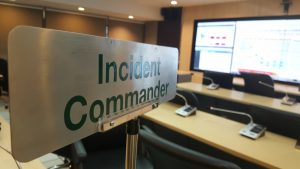Back to Basics is a weekly feature that highlights important but possibly overlooked information that any EHS professional should know. This week, we examine how to create a crisis communications plan.
When disaster strikes your business, you need to respond, but you also need to communicate. This includes letting customers know if your business operations are disrupted and how it will affect them, keeping employees and their families apprised of the situation, staying in touch with regulators and local government officials if necessary, and informing any neighbors about what’s going on.
Developing a crisis communications plan will help you respond promptly, accurately, and confidently during and after an emergency. The Federal Emergency Management Agency (FEMA) provides good information about how to put together a crisis communications plan through Ready.gov.
Know your audiences
When developing a plan for crisis communications, you need to determine who you will need to reach during an emergency. Each potential audience will need to have information during and after an incident that is tailored for its own needs. In addition, you’ll need to determine what they need for information and who in your business is best able to communicate with that audience.
Here is a list of potential audiences, according to Ready:
- Customers
- Survivors affected by the incident and their families
- Employees and their families
- News media
- Community, especially neighbors living near the business
- Company management, directors, and investors
- Elected government officials, regulators, and other authorities
- Suppliers
Compile contact information for each audience and ensure it is immediately accessible during an emergency. This could include existing information such as customer, supplier, and employee contact information that you can export from your databases. Include as much information for each contact as possible like organization name, contact name, business telephone number, cell number, and email address. Make sure you update lists regularly, secure them to protect confidential information, and make them available to authorized users at the emergency operations center or another location for the crisis communications team to use. Electronic lists can be hosted on a secure server for remote access and hard copies should be available at the alternate location.
Customer contact is a top priority. Your plan should include action to redirect incoming phone calls to a second call center if possible or to a voice message indicating that the business is dealing with a temporary situation. You should also have procedures in place to inform customers about the status of orders in process at the time of the incident.
Customer service or sales staff should be assigned to communicate with customers in case of an incident. If you have a lot of customers, prioritize the list to reach the most important customers first.
Your crisis communication plan should also include procedures for notifying suppliers, including when and how they should be notified.
In addition, your plan should detail protocols for when to notify management of an incident. Staff should be aware which situations require immediate notification of management regardless of the time of day. Similarly, have protocols and procedures in place to notify directors, investors, and other important stakeholders.
How you communicate with government officials depends on the nature and severity of the incident and regulatory requirements. You could face a fine if you fail to notify a regulator within a prescribed time; OSHA requires notification to the agency when there are three or more hospitalizations from an accident or if there is a fatality. Environmental regulations require notification in case of a chemical spill or release that exceeds threshold quantities. Other regulators may need to be informed if there is an incident involving product tampering, contamination, or quality. Your crisis communications plan should document notification requirements specified in regulations. In addition, a major incident will concern elected officials, so you should assign a senior manager to communicate with elected officials and public safety officials.
Human resources (HR) is responsible for day-to-day communications with employees, so they should act similarly with crisis communications. HR should coordinate communications with management, supervisors, employees, and families.
If the facility has hazards that impact the surrounding community, community outreach should part of the crisis communications plan. This should include coordination with public safety officials to develop procedures to advise the public of any hazards. A company policy should dictate that only authorized spokespersons are permitted to speak to the news media. Determine in advance who will speak to the media and prepare the person with talking points.
Contact and information centers
To deal with questions and requests for information about an emergency, you should have a communications hub to manage the flow of information. Contact and information centers form the hub of the crisis communications plan. The contact center fields inquiries from customers, suppliers, news media, and others, while the information center uses existing staff and technologies that deal with requests for information from customers, employees, and others during normal business hours.
Resources should be available with in the primary business site and similar capabilities should be set up at an alternate site in case the primary site can’t be used. Ready suggests having the following resources:
- Telephones with dedicated or addressable lines for incoming calls and separate lines for outgoing calls
- Access to an electronic notification system used to inform employees
- Access to email and a fax machine
- Webmaster access to company website to post updates
- Access to social media accounts
- Access to local area network, secure remote server, message template library, and printers
- Hard copies of emergency response, business continuity, and crisis communications plans
- Site and building diagrams, information related to business processes and loss prevention programs

